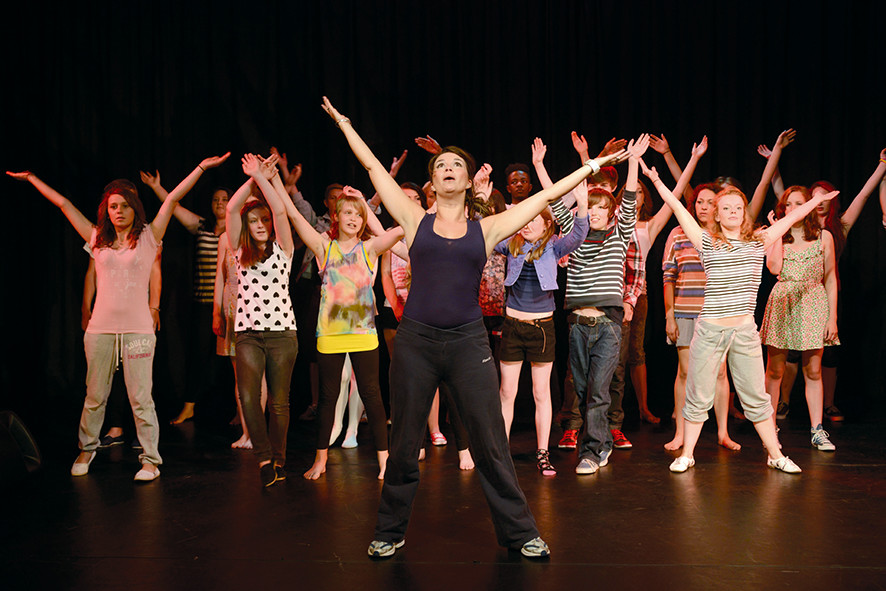Singing is a beautiful form of expression, but it can be challenging for some people to sing on key. Fortunately, with the right techniques and approach, anyone can learn how to sing on key. In this article, we will provide you with some tips and tricks on how to teach someone to sing on key.
1. Start with Breathing Exercises

The first step in learning how to sing on key is to start with breathing exercises. Proper breathing is essential for good singing, as it helps to control the voice and maintain proper pitch. Encourage your student to take deep breaths and focus on their diaphragm as they exhale. This will help them to develop proper breath support and control.
2. Teach Them to Listen

Listening is a crucial skill for singing on key. Encourage your student to listen carefully to the melody, rhythm, and pitch of the song. Ask them to identify the notes and intervals and try to replicate them with their voice. This will help them to develop better pitch recognition and control.
3. Practice Scales and Exercises

Practicing scales and exercises is an excellent way to improve pitch accuracy and control. Start with simple scales and gradually increase the difficulty level. Encourage your student to practice regularly and focus on maintaining proper pitch and control.
4. Use Visual Aids

Visual aids can be a helpful tool in teaching someone to sing on key. Use a piano or keyboard to show your student the notes and intervals in the song. This will help them to visualize the pitch and develop better pitch recognition.
5. Record and Listen Back

Recording and listening back to your singing is an excellent way to identify areas for improvement. Encourage your student to record their voice and listen back to it. This will help them to identify areas where they need to improve and work on their pitch accuracy.
6. Encourage Them to Sing Regularly

Practice makes perfect, and singing is no exception. Encourage your student to sing regularly, whether it's in the shower, in the car, or while doing household chores. This will help them to develop better pitch recognition and control and improve their overall singing ability.
7. Provide Constructive Feedback

Providing constructive feedback is essential in helping someone to improve their singing ability. Be honest but kind in your feedback, and focus on specific areas where your student can improve. This will help them to develop better pitch accuracy and control.
8. Use Vocal Warm-Ups

Vocal warm-ups are an excellent way to prepare your voice for singing and improve your pitch accuracy and control. Start with simple warm-up exercises and gradually increase the difficulty level. Encourage your student to focus on maintaining proper breath support and control.
9. Experiment with Different Genres

Experimenting with different genres of music can be an excellent way to improve pitch accuracy and control. Encourage your student to sing different types of music and styles, from classical to pop. This will help them to develop better pitch recognition and control and improve their overall singing ability.
10. Be Patient and Encouraging

Learning to sing on key takes time and patience, so be patient and encouraging with your student. Focus on their progress and celebrate their successes, no matter how small they may seem. This will help to build their confidence and motivate them to continue to improve their singing ability.
11. Practice Sight-Singing

Sight-singing is an excellent way to develop better pitch accuracy and control. Encourage your student to practice sight-singing by looking at a piece of sheet music and singing the notes without playing them on an instrument. This will help them to develop better pitch recognition and control.
12. Use a Pitch Pipe
A pitch pipe is a simple tool that can be used to help someone develop better pitch accuracy and control. Encourage your student to use a pitch pipe to find the starting note of a song and to check their pitch accuracy throughout the song.
13. Practice Vibrato

Vibrato is a technique used by singers to add depth and emotion to their singing. Encourage your student to practice vibrato by starting with a slow and controlled vibrato and gradually increasing the speed and intensity.
14. Use Vocal Exercises

Vocal exercises can be an excellent way to improve pitch accuracy and control. Use exercises that focus on specific areas where your student needs to improve, such as breath support, pitch recognition, or vibrato.
15. Practice Singing with Accompaniment

Practicing singing with accompaniment, such as a piano or guitar, can be an excellent way to improve pitch accuracy and control. Encourage your student to focus on maintaining proper pitch and control while singing with accompaniment.
16. Use Online Resources

There are many online resources available that can help someone learn to sing on key. Encourage your student to use online tutorials, videos, and exercises to supplement their in-person lessons.
17. Join a Choir or Singing Group

Joining a choir or singing group can be an excellent way to improve your pitch accuracy and control. Encourage your student to join a local choir or singing group to gain experience and practice their singing skills with others.
18. Practice with a Piano or Keyboard

Practicing with a piano or keyboard can be an excellent way to improve pitch recognition and control. Encourage your student to practice singing along with a piano or keyboard to develop better pitch accuracy and control.
19. Work on Diction and Pronunciation

Diction and pronunciation are crucial for good singing. Encourage your student to work on their diction and pronunciation by focusing on clear and precise articulation of words and phrases.
20. Have Fun!

Most importantly, have fun! Singing is a beautiful form of expression and should be enjoyed. Encourage your student to have fun and explore their voice, and remember to celebrate their successes along the way.